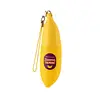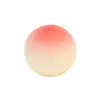What's inside
What's inside
 Key Ingredients
Key Ingredients

 Benefits
Benefits

 Concerns
Concerns

 Ingredients Side-by-side
Ingredients Side-by-side

Petrolatum
EmollientPolybutene
Silica Silylate
EmollientVp/Hexadecene Copolymer
Diisostearyl Malate
EmollientTocopheryl Acetate
AntioxidantCI 77891
Cosmetic ColorantParfum
MaskingPolyethylene
AbrasiveDehydroacetic Acid
PreservativePolyglyceryl-2 Triisostearate
EmulsifyingCI 19140
Cosmetic ColorantSilica Dimethyl Silylate
EmollientMusa Sapientum Fruit Extract
Skin ConditioningCeramide NP
Skin ConditioningCocos Nucifera Oil
MaskingMilk Protein Extract
Water
Skin ConditioningButylene Glycol
Humectant1,2-Hexanediol
Skin ConditioningPhenoxyethanol
PreservativePetrolatum, Polybutene, Silica Silylate, Vp/Hexadecene Copolymer, Diisostearyl Malate, Tocopheryl Acetate, CI 77891, Parfum, Polyethylene, Dehydroacetic Acid, Polyglyceryl-2 Triisostearate, CI 19140, Silica Dimethyl Silylate, Musa Sapientum Fruit Extract, Ceramide NP, Cocos Nucifera Oil, Milk Protein Extract, Water, Butylene Glycol, 1,2-Hexanediol, Phenoxyethanol
Petrolatum
EmollientDiisostearyl Malate
EmollientButyrospermum Parkii Butter
Skin ConditioningCarthamus Tinctorius Seed Oil
MaskingDipentaerythrityl Hexahydroxystearate/Hexastearate/Hexarosinate
Skin ConditioningBeeswax
Emulsion StabilisingCeresin
Emulsion StabilisingParfum
MaskingSorbitan Sesquioleate
EmulsifyingCopernicia Cerifera Wax
Paraffin
PerfumingTocopheryl Acetate
AntioxidantPolyglyceryl-2 Triisostearate
EmulsifyingWater
Skin ConditioningSodium Hyaluronate
HumectantCeramide NP
Skin ConditioningRosa Canina Fruit Oil
EmollientButylene Glycol
HumectantLanolin Wax
EmollientMelaleuca Alternifolia Leaf Oil
AntioxidantAlcohol
AntimicrobialPrunus Persica Fruit Extract
AbrasiveHamamelis Virginiana Extract
AntiseborrhoeicCI 19140
Cosmetic ColorantCI 15850
Cosmetic ColorantButylparaben
MaskingPhenoxyethanol
PreservativePetrolatum, Diisostearyl Malate, Butyrospermum Parkii Butter, Carthamus Tinctorius Seed Oil, Dipentaerythrityl Hexahydroxystearate/Hexastearate/Hexarosinate, Beeswax, Ceresin, Parfum, Sorbitan Sesquioleate, Copernicia Cerifera Wax, Paraffin, Tocopheryl Acetate, Polyglyceryl-2 Triisostearate, Water, Sodium Hyaluronate, Ceramide NP, Rosa Canina Fruit Oil, Butylene Glycol, Lanolin Wax, Melaleuca Alternifolia Leaf Oil, Alcohol, Prunus Persica Fruit Extract, Hamamelis Virginiana Extract, CI 19140, CI 15850, Butylparaben, Phenoxyethanol
Ingredients Explained
These ingredients are found in both products.
Ingredients higher up in an ingredient list are typically present in a larger amount.
Butylene Glycol (or BG) is used within cosmetic products for a few different reasons:
Overall, Butylene Glycol is a safe and well-rounded ingredient that works well with other ingredients.
Though this ingredient works well with most skin types, some people with sensitive skin may experience a reaction such as allergic rashes, closed comedones, or itchiness.
Learn more about Butylene GlycolCeramide NP is a type of ceramide and formally known as ceramide 3.
Ceramides are intercellular lipids naturally found in our skin that bonds dead skin cells together to create a barrier. They are known for their ability to hold water and thus are a great ingredient for dry skin.
Ceramides are an important building block for our skin barrier. A stronger barrier helps the skin look more firm and hydrated. By bolstering the skin ceramides act as a barrier against irritating ingredients. This can help with inflammation as well.
If you would like to eat ceramides, sweet potatoes contain a small amount.
Read more about other common types of ceramides here:
Ceramide AP
Ceramide EOP
CI 19140 is also known as Tartrazine. Tartrazine is a synthetic dye used in cosmetics, foods, and medicine to add a yellow color.
Tartrazine is created from petroleum and is water-soluble.
Some people may experience allergies from this dye, especially asthmatics and those with an aspirin intolerance.
Learn more about CI 19140Diisostearyl Malate is an emollient and most often used in lip products. It comes from isostearyl alcohol, a fatty acid, and malic acid, an AHA.
As an emollient, Diisostearyl Malate helps create a thin film on your skin to trap moisture in. This helps keep your skin soft and smooth.
Parfum is a catch-all term for an ingredient or more that is used to give a scent to products.
Also called "fragrance", this ingredient can be a blend of hundreds of chemicals or plant oils. This means every product with "fragrance" or "parfum" in the ingredients list is a different mixture.
For instance, Habanolide is a proprietary trade name for a specific aroma chemical. When used as a fragrance ingredient in cosmetics, most aroma chemicals fall under the broad labeling category of “FRAGRANCE” or “PARFUM” according to EU and US regulations.
The term 'parfum' or 'fragrance' is not regulated in many countries. In many cases, it is up to the brand to define this term.
For instance, many brands choose to label themselves as "fragrance-free" because they are not using synthetic fragrances. However, their products may still contain ingredients such as essential oils that are considered a fragrance by INCI standards.
One example is Calendula flower extract. Calendula is an essential oil that still imparts a scent or 'fragrance'.
Depending on the blend, the ingredients in the mixture can cause allergies and sensitivities on the skin. Some ingredients that are known EU allergens include linalool and citronellol.
Parfum can also be used to mask or cover an unpleasant scent.
The bottom line is: not all fragrances/parfum/ingredients are created equally. If you are worried about fragrances, we recommend taking a closer look at an ingredient. And of course, we always recommend speaking with a professional.
Learn more about ParfumPetrolatum is more commonly known as petroleum jelly. It is created by mixing waxes and mineral oils.
This ingredient is effective at reducing water loss by 99%. This is because it is an occlusive. Occlusives create a hydrophobic barrier on the skin to prevent evaporation. This property makes it great for hydrating dry skin.
Pro tip: Use occlusives, such as this ingredient, on damp skin for the best results.
The quality or origin of petrolatum is only known when disclosed by the brand. Most cosmetic petrolatum has gone through several purification stages.
Another benefit of occlusives is it protects your skin against infection or allergies.
Petrolatum may not be safe for fungal-acne. Studies show mineral oil / petroleum leads to the growth of M. Furfur, a type of yeast.
Learn more about PetrolatumPhenoxyethanol is a preservative that has germicide, antimicrobial, and aromatic properties. Studies show that phenoxyethanol can prevent microbial growth. By itself, it has a scent that is similar to that of a rose.
It's often used in formulations along with Caprylyl Glycol to preserve the shelf life of products.
This ingredient is a form of glycerin with emulsifying and emollient properties.
As an emulsifier, this ingredient helps keep products together while adding a thick texture. The manufacturer states this ingredient has emollient properties. Emollients help keep the skin hydrated by trapping moisture in.
Polyglyceryl-2 Triisostearate is created by reacting diglycerin and isostearic acid. Due to the isostearic acid base, it may not be safe for Malassezia or fungal acne.
Learn more about Polyglyceryl-2 TriisostearateTocopheryl Acetate is AKA Vitamin E. It is an antioxidant and protects your skin from free radicals. Free radicals damage the skin by breaking down collagen.
One study found using Tocopheryl Acetate with Vitamin C decreased the number of sunburned cells.
Tocopheryl Acetate is commonly found in both skincare and dietary supplements.
Learn more about Tocopheryl AcetateWater. It's the most common cosmetic ingredient of all. You'll usually see it at the top of ingredient lists, meaning that it makes up the largest part of the product.
So why is it so popular? Water most often acts as a solvent - this means that it helps dissolve other ingredients into the formulation.
You'll also recognize water as that liquid we all need to stay alive. If you see this, drink a glass of water. Stay hydrated!
Learn more about Water